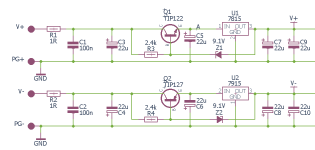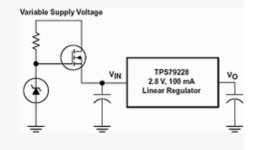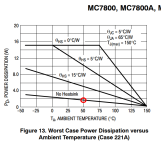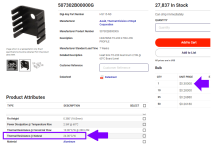Hi,
I need some advice how to increase input voltage in LDO? Input voltage will be double +-50V. I need to build psu for preamp. So L7815CV; L7915CV max input 34V so it will fail.
I found circuit, I think its good idea, but I wanna use transistors BD139 & BD140 instead mosfets. Can someone help me and draw circuit? Resistor values etc. Zener I will choose 24V
Thank you!
I need some advice how to increase input voltage in LDO? Input voltage will be double +-50V. I need to build psu for preamp. So L7815CV; L7915CV max input 34V so it will fail.
I found circuit, I think its good idea, but I wanna use transistors BD139 & BD140 instead mosfets. Can someone help me and draw circuit? Resistor values etc. Zener I will choose 24V
Thank you!
Attachments
With 50V in and 15V out you do not need an LDO so you can use anything.
There is a 60V version of the LM317.
The schematic shows 2.8V, is that the output voltage you need?
What outpuyt current do you need?
Jan
There is a 60V version of the LM317.
The schematic shows 2.8V, is that the output voltage you need?
What outpuyt current do you need?
Jan
Schematic its just example. I need double output +-15. Input +-50V. L7815CV; L7915CV max input 34v
With 50V in and 15V out you do not need an LDO so you can use anything.
Jan, you are absolutely right. There are many people, even professional electronic design engineers, who don't seem to remember that LDO is not a generic term for a series regulator, but an abbreviation of low drop-out.
If SMDs are acceptable, the LT3011 is also an alternative.
Edit: no, it isn't for 100 mA to 200 mA.
How about LM317, they are available for 60V Vin?Schematic its just example. I need double output +-15. Input +-50V. L7815CV; L7915CV max input 34v
Also better regulation and lower noise than 78xx.
I need to check if LM337 is available for >50V, don't know.
Do you have separate transformer secondaries?
Jan
its car amp but designed really strange in preamp voltage: +14.88/-14.2V so for my project balanced board I will do proper. +-15V. yes LM317HV 60V thank u, but looking LM337 at the moment there is -60V. I can go with smd as well it will be better I need small size pcb + current <200mA. Maybe there is another alternative smdHow about LM317, they are available for 60V Vin?
Also better regulation and lower noise than 78xx.
I need to check if LM337 is available for >50V, don't know.
Do you have separate transformer secondaries?
Jan
BD139/140 will have a hard time to get rid of 7W.
That needs a careful thermal design, especially in cars that can easily get 100deg.
Jan
That needs a careful thermal design, especially in cars that can easily get 100deg.
Jan
It can be anything you want. My advice would still be an LM337 and LM117 with say +/-30V out, followed by a 78xx and 79xx.
Remember that the 40V max for the '337 is between input and output. With 50V in and 30V out that's just 20V I/O difference. *
Only needs a protection zener for the start-up phase.
The beauty is that you can spread that 7W across 2 devices.
Take a look at the typical circuits in the data sheets and come back with a circuit we can take a look at.
Jan
*Even a 78xx and 79xx can withstand 35V I/O but that's cutting it close.
Remember that the 40V max for the '337 is between input and output. With 50V in and 30V out that's just 20V I/O difference. *
Only needs a protection zener for the start-up phase.
The beauty is that you can spread that 7W across 2 devices.
Take a look at the typical circuits in the data sheets and come back with a circuit we can take a look at.
Jan
*Even a 78xx and 79xx can withstand 35V I/O but that's cutting it close.
For that voltage drop a DC-DC converter before the regulator is probably the best approach, there are plenty of DC-DC converters with 18 to 72V input range for instance.
Agree with Mark. Small space(limited heat sinking), rough environment(could be 120F in phoenix) all point to minimizing power dissipation in the regulator.
Why not connect three 1N5347B zener diodes in series, upstream of a plain ordinary 3-terminal regulator IC? Each Zener diode is rated 5 watts but in your application, actually dissipates only 1-2 watts. Each diode drops 10 volts, so the chain of 3 diodes in series drops 30 volts, leaving 20 volts across the 3-terminal regulator. And it was so easy.
Regarding DC-DC converters: it would be nice to know if whatever is being supplied is sensitive to ultrasonic interference.
Edit: I just reread post #1. It's a preamp, so chances are it will work fine, especially with a good post regulator.
Edit: I just reread post #1. It's a preamp, so chances are it will work fine, especially with a good post regulator.
You can cascode ordinary three-pin regulators with transistors like this:

This is much simpler than a DC-DC converter and better than zeners in series with the raw supply (three-pin regulators tend to perform better when the voltage across them is fixed). You can vary the zener's voltage (choose the resistors accordingly) to adjust the split of power dissipation between the transistor and the regulator. Depending on that split, either or both of the transistor and the regulator would need to be heatsinked - (50V-15V)×0.2A=7W total dissipation per rail requires a sizable heatsink. If most of the dissipation is given the the transistor, it makes sense to bolt the regulator to the same heatsink - in case of over-temperature, its internal protection will shut down the whole thing.
Also, the input filter resistor can be large - it will dissipate part of the heat and will add some filtering, too.

This is much simpler than a DC-DC converter and better than zeners in series with the raw supply (three-pin regulators tend to perform better when the voltage across them is fixed). You can vary the zener's voltage (choose the resistors accordingly) to adjust the split of power dissipation between the transistor and the regulator. Depending on that split, either or both of the transistor and the regulator would need to be heatsinked - (50V-15V)×0.2A=7W total dissipation per rail requires a sizable heatsink. If most of the dissipation is given the the transistor, it makes sense to bolt the regulator to the same heatsink - in case of over-temperature, its internal protection will shut down the whole thing.
Also, the input filter resistor can be large - it will dissipate part of the heat and will add some filtering, too.
It's a car amp with +/- 50V so it already has a wonderful switcher and the car has 12 ...14V battery voltage anyway so why take the highest available voltage?! Adding a second small 5W switcher to convert 12V to +/- 15V at 100 mA is simplest solution. A CLC in each supply line will make it good enough for car use.
36 x 23 x 8.5 mm, that is tiny:
https://www.digikey.de/en/products/detail/tdk-lambda-americas-inc/CC10-1212DF-E/920396
If you measure the current to be below 100 mA this one is even tinier with 23 x 17 x 8.5 mm (this text is longer than the real life SMPS):
https://www.digikey.de/en/products/detail/tdk-lambda-americas-inc/CC3-1212DF-E/920432
No excess heat seems an important parameter besides small size in this case.
36 x 23 x 8.5 mm, that is tiny:
https://www.digikey.de/en/products/detail/tdk-lambda-americas-inc/CC10-1212DF-E/920396
If you measure the current to be below 100 mA this one is even tinier with 23 x 17 x 8.5 mm (this text is longer than the real life SMPS):
https://www.digikey.de/en/products/detail/tdk-lambda-americas-inc/CC3-1212DF-E/920432
No excess heat seems an important parameter besides small size in this case.
Last edited:
10 volt, 5 watt zener diodes need no heatsink when conducting 100-200mA, which is an advantage. Let the 3T voltage regulator IC provide the PSRR and let the zeners drop the excess input voltage. With 20V in and 15V out and 200mA load, the 3T voltage regulator dissipates 1 watt, which according to its datasheet (attachment 1) means that the regulator doesn't require a heatsink either. However if you prefer lots and LOTS of excess safety margin, a very inexpensive bolt-on heatsink will cool the 3T regulator quite nicely (attachment 2) without needing to touch the equipment chassis.
_
_
Attachments
- Home
- Amplifiers
- Power Supplies
- High input LDO regulator


